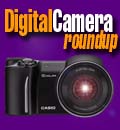 It's been almost five years since we published the first issue of Digital Camera Magazine. We're proud that we were among the first to see the enormous potential of this new technology, and the first to dedicate an entire magazine to digital cameras. When our premiere issue hit the newsstands, even experts still viewed digital cameras as nothing more than quirky peripherals that let you capture low-resolution images and display them on your PC. The mere thought that digital cameras might some day replace film was considered preposterous. Well, looks like we were right. In 2002, digital cameras outsold film cameras in the United States, not counting disposables for which there is no digital equivalent yet. Wow.
It's been almost five years since we published the first issue of Digital Camera Magazine. We're proud that we were among the first to see the enormous potential of this new technology, and the first to dedicate an entire magazine to digital cameras. When our premiere issue hit the newsstands, even experts still viewed digital cameras as nothing more than quirky peripherals that let you capture low-resolution images and display them on your PC. The mere thought that digital cameras might some day replace film was considered preposterous. Well, looks like we were right. In 2002, digital cameras outsold film cameras in the United States, not counting disposables for which there is no digital equivalent yet. Wow.
During these five years digital cameras have become part of my life. I've reviewed a good number of them for the pages of this magazine and I am thrilled by how much more powerful they have become in just a few short years. However, they aren't perfect yet, and I've been using this column to highlight some the quirks and growing pains of an emerging technology and bemoan some of the more boneheaded features and decisions. My comments are based on personal observation and the feedback we're getting from our readers. So let's see where we stand at the end of 2002.
On the plus side, we've seen tremendous progress. In just over half a decade, digital cameras went from being bulky, battery-eating contraptions able to capture images barely good enough for display on a computer screen to vastly more efficient and sophisticated precision instruments capable of capturing many megapixels of image information at a fraction of the cost.
Unfortunately, the tremendous advances in power, resolution, and several other areas has been somewhat offset by a number of glitches and nuisances typical of technologies in progress. In this column I will highlight some of them in the hope that the industry will address them sooner or later.
LCD displays - Maybe it is my advancing age and need to wear reading glasses that fuel a growing frustrating with digital camera LCDs. Not only do they seem to get smaller and smaller and are now barely larger than postage stamps, but they are still as illegible as ever in the great outdoors where most people use their cameras. These appallingly tiny screens completely offset one of the greatest advantages of digital cameras, the ability to preview a picture and make sure it came out okay. If you're dealing with a 1.5-inch LCD, even zooming in won't tell you if the image is actually sharp or if you have to re-shoot. As for readability, the vast majority of digital camera LCDs are standard transmissive
TFTs - Some manufacturers claim special coatings improve readability of their displays but I really can't see much of a difference. So while most color PDAs now have glorious transflective displays that are equally bright and readable indoors and outdoors, even expensive digicams have tiny murky screens that you can't see in sunlight. Not good. Especially since more and more menu information is being displayed on those micro screens.
LCD status displays - or rather the lack of them. More and more of the digicams appearing in our labs no longer have a secondary monochrome "status display" LCD that shows the camera's settings. Such displays are enormously useful. You can glance at them to get a reading of all settings, and you can do so even in the brightest sunlight. Without them, all information is crammed onto that tiny color LCD that now must do double duty as both an image viewer and a menu display. And since the LCD is often unreadable outdoors, the manual controls of an expensive digicam can become utterly useless unless you find a shady spot to make out what's on the screen.
Menus and controls - The good news here is that at least some digital camera manufacturers seem to have more or less agreed on a standard complement of buttons and controls. As a result it is now possible to pick up competing brand cameras and not be completely lost. Let's see, okay, the gas is on the right, the break on the left. Good. The bad news is that no such standardization ever happened with menus. The Digita attempt of creating a unified interface and OS for digicams failed, and now everyone rolls their own.
Icons - The above mentioned menu and controls chaos is exacerbated by a veritable Tower of Babel situation when it comes to icons and labeling. Most cameras use text, icons, and labels of various sizes and degrees of comprehensibility to an extent that would baffle an Egyptologist. An arrow in a box? Three dots in a circle? A triangle with waves? What does it all mean? Who designed that stuff? Who can decipher it?
Batteries - Again a good news/bad news situation. The good news is that the days of battery-eating digicams are pretty much over. It is still hard to understand how a set of batteries can power a motor-driven electronic film SLR camera while a high-tech Lithium pack lasts just a few hours in a tiny digicam, but that's the price of progress I suppose. My problem is with the increasing use of proprietary power packs instead of standard format batteries and rechargeables. Okay, AAs are kind of big and you usually need four to power a digicam, but I'd much rather rely on them than on some one-of-a-kind pack that will leave me stranded unless I happen to have a charged (and usually very expensive) spare.
Storage media - Good news/bad news again. Good news is that the capacity of storage cards is growing faster than the storage requirements of ever-higher resolution digicams. And card prices have come down a lot. The bad news is that I wish they could agree on one or perhaps two storage card standards. Is this just a power grab to lock consumers into a brand? I mean, after you spend a few hundred dollars on Memory Sticks, you're likely going to buy another memory Stick camera. However, all those standards mean endless problems with incompatible formats and multiple drivers and for them.
Shovelware - One of my favorites. Not. As much as I appreciate the value-added the extra software that comes bundled with most digicams provides, I want for that software to be useful. Too much of it qualifies as mere "shovelware" or worse. I don't need a CD that installs hundreds of megabytes of trial and "light" versions of mediocre software onto my computer whether I like it or not. And I am downright allergic to "bonus" software that installs itself and then either wipes out legitimate versions of the same software on my computer or demands that I remove software I already own. Grrr.
Card readers-If I never see another cable connecting a digicam directly to a computer, that'd be fine with me. Those cables are almost never labeled, which means I'll lose them; they invariably have flimsy tiny proprietary micro connectors that break or bend; and they almost always require special software that will only work with that particular camera (and often none too well at that). With the price of multi-format card readers having come way down and USB ports ubiquitous, I'd much rather do away with the cables entirely and simply use card readers. Yet, I don't think I've seen many digicams that come bundled with a reader.
So there you have it. We've come a long way, but there's still ways to go. Fortunately, most of my gripes are design and standard related. So, dear vendors, with all those wonderful technological advances, let's not forget the basics: We need bigger displays that can actually be read, controls and menus that make sense, a semblance of standardization in storage, batteries and connectivity, and software that won't take over our PCs. Seems reasonable, doesn't it?








